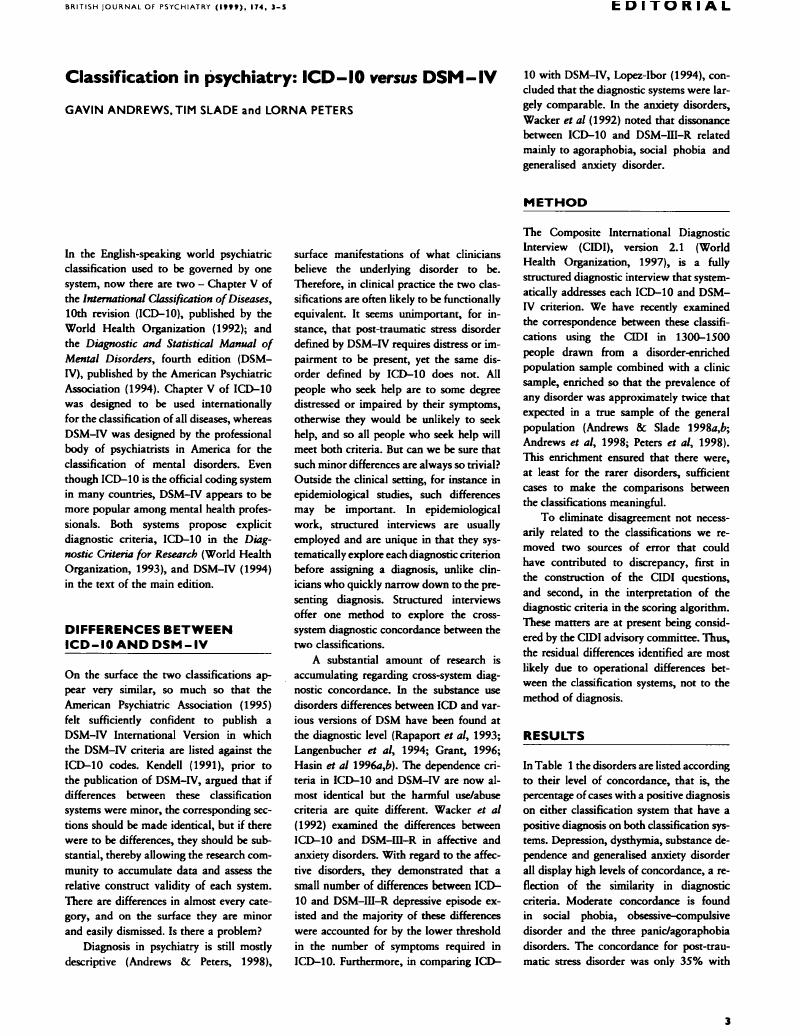Crossref Citations
This article has been cited by the following publications. This list is generated based on data provided by Crossref.
First, Michael B.
and
Pincus, Harold Alan
1999.
Classification in psychiatry: ICD–10 v. DSM–IV.
British Journal of Psychiatry,
Vol. 175,
Issue. 3,
p.
205.
Andrews, Gavin
1999.
Classification in the anxiety disorders.
Current Opinion in Psychiatry,
Vol. 12,
Issue. 2,
p.
149.
Farmer, A.
and
McGuffin, P.
1999.
Comparing ICD–10 and DSM–IV.
British Journal of Psychiatry,
Vol. 175,
Issue. 6,
p.
587.
Koopowitz, L. F.
1999.
The Role of the Brain in Psychiatry: Implications for the Specialist Practice of Psychiatry.
Australasian Psychiatry,
Vol. 7,
Issue. 5,
p.
253.
Watson, Paddy Burges
2000.
Book Review: Posttraumatic Stress Disorder: Concepts and Therapy.
Australian & New Zealand Journal of Psychiatry,
Vol. 34,
Issue. 5,
p.
887.
Anderson, I. M.
Nutt, D. J.
and
Deakin, J. F. W.
2000.
Evidence-based guidelines for treating depressive disorders with antidepressants: a revision of the 1993 British Association for Psychopharmacology guidelines.
Journal of Psychopharmacology,
Vol. 14,
Issue. 1,
p.
3.
Burges Watson, Paddy
2000.
Posttraumatic stress disorder: concepts and therapy.
Australian and New Zealand Journal of Psychiatry,
Vol. 34,
Issue. 5,
p.
887.
Ihle, Wolfgang
Esser, Günter
Schmidt, Martin H.
and
Blanz, Bernd
2000.
Prävalenz, Komorbidität und Geschlechtsunterschiede psychischer Störungen vom Grundschul- bis ins frühe Erwachsenenalter.
Zeitschrift für Klinische Psychologie und Psychotherapie,
Vol. 29,
Issue. 4,
p.
263.
Dengler, W.
2000.
Leitlinien zur Diagnostik und Therapie von Angsterkrankungen.
p.
1.
Andrews, Gavin
2000.
The anxiety disorder inclusion and exclusion criteria in DSM-IV and ICD-10.
Current Opinion in Psychiatry,
Vol. 13,
Issue. 2,
p.
139.
Andrews, G.
2001.
International Encyclopedia of the Social & Behavioral Sciences.
p.
15388.
CASEY, PATRICIA
2001.
Adult Adjustment Disorder: A Review of Its Current Diagnostic Status.
Journal of Psychiatric Practice,
Vol. 7,
Issue. 1,
p.
32.
Ayuso-Mateos, Jose Luis
Vázquez-Barquero, Jose Luis
Dowrick, Christopher
Lehtinen, Ville
Dalgard, Odd Steffen
Casey, Patricia
Wilkinson, Clare
Lasa, Lourdes
Page, Helen
Dunn, Graham
and
Wilkinson, Greg
2001.
Depressive disorders in Europe: prevalence figures from the ODIN study.
British Journal of Psychiatry,
Vol. 179,
Issue. 4,
p.
308.
Ottosson, Hans
Ekselius, Lisa
Grann, Martin
and
Kullgren, Gunnar
2002.
Cross-System Concordance of Personality Disorder Diagnoses of DSM-IV and Diagnostic Criteria for Research of ICD-10.
Journal of Personality Disorders,
Vol. 16,
Issue. 3,
p.
283.
Rosenman, Stephen
2002.
Trauma and Posttraumatic Stress Disorder in Australia: Findings in the Population Sample of the Australian National Survey of Mental Health and Wellbeing.
Australian & New Zealand Journal of Psychiatry,
Vol. 36,
Issue. 4,
p.
515.
2003.
Australian and New Zealand Clinical Practice Guidelines for the Treatment of Panic Disorder and Agoraphobia.
Australian & New Zealand Journal of Psychiatry,
Vol. 37,
Issue. 6,
p.
641.
Gavranidou, Maria
and
Rosner, Rita
2003.
The weaker sex? Gender and post-traumatic stress disorder.
Depression and Anxiety,
Vol. 17,
Issue. 3,
p.
130.
2003.
Australian and New Zealand clinical practice guidelines for the treatment of panic disorder and agoraphobia.
Australian and New Zealand Journal of Psychiatry,
Vol. 37,
Issue. 6,
p.
641.
Hildebrandt, M. G.
Stage, K. B.
and
Kragh‐Soerensen, P.
2003.
Gender and depression: a study of severity and symptomatology of depressive disorders (ICD‐10) in general practice.
Acta Psychiatrica Scandinavica,
Vol. 107,
Issue. 3,
p.
197.
Bressan, Rodrigo A
Chaves, Ana C
Pilowsky, Lyn S
Shirakawa, Itiro
and
Mari, Jair J
2003.
Depressive episodes in stable schizophrenia: critical evaluation of the DSM-IV and ICD-10 diagnostic criteria.
Psychiatry Research,
Vol. 117,
Issue. 1,
p.
47.






eLetters
No eLetters have been published for this article.